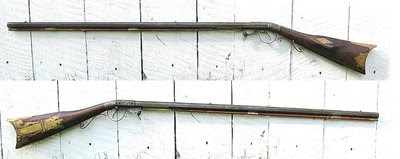
Brent Gurtek is also such a man and we thank him for sharing some photos of his first underhammer project. In a phone interview with this full time gunmaker, he said his usual work consists of Kentucky rifles and similar side-locked firearms of the 1750-1850-period. However, he always harbored a love for underhammer sporting arms. Recently he decided to finally take the plunge into the pool of underhammer makers. He brought his experience with longrifles to the bench to create this unique underhammer which exudes the innovative design and flavor of an original piece of the early 19th century.

Brent said that his rifle wears a 36-inch octagonal, straight-tapered (1" - 7/8") .50-caliber round-ball barrel by Ed Rayl. The tapered barrel lends a wonderful sense of balance to the finished rifle, both in handling characteristics as well as aesthetics, and unbeknownst to many, it also provides superior accuracy.
The case-hardened action is made by Charles Bowers and features the simple logic of the time-honored triggerguard/mainspring construction. The Bowers action uses Allen screws (unfortunately) to secure the barrel/receiver connection for ease of take-down and barrel swapping for those who are inclined to shoot two or more calibers (or bird shot) from the same platform.


Brent chose curly English walnut for the stock and its mountings are brass. He claims that his patchbox design is loosely based on others from eastern Pennsylvania and reflects his longrifle background. It certainly seems to “date” the piece as an early transitional type of percussion rifle just emerging from the Golden Age. Brent then tastefully antiqued the whole rifle to give it the flavor of a well-maintained original.
Brent’s manner of fixing the ramrod pipes to the barrel provides a rigid and durable arrangement. The “pipes” are made of brass sheet having a flange that is soldered to the barrel and decorated in appropriate manner. All in all a very nice treatment and one which displays the ingenuity of frontier gunmakers who had little in the way of machinery to provide the methods of construction employed by the factories and even some of the more established gunmakers in the more settled areas of the East.
 Brent fabricated the ramrod thimbles from brass sheet which he
Brent fabricated the ramrod thimbles from brass sheet which hesoldered to the barrel for a wonderful frontier gunmaker's look.
“I make most of the bits & pieces for my guns, preferring to use ’catalog’ parts as little as possible." says Brent. "The sights and butt plate shown here are both of my own manufacture.” he adds. It is that fabrication of his own “bits and pieces” that lend that certain individuality to his work. He also stated that he’s been diligently working on an underhammer design of his own which we hope to see in the near future. Brent sums it all up by saying, “Underhammers are inadequately appreciated by modern muzzle loading shooters and THAT MUST CHANGE!!” To help remedy that situation he is presently involved with three other underhammer projects and plans to continue to build underhammer rifles, too.
 Since the original posting, we received this pic of the nice doe that Brent harvested with the rifle displayed above. Way to go, Brent!
Since the original posting, we received this pic of the nice doe that Brent harvested with the rifle displayed above. Way to go, Brent!Just a reminder that clicking on the images will enlarge them. Clicking the "Back" arrow will return you to the text.
All photos copyrighted by Brent Gurtek
No comments:
Post a Comment